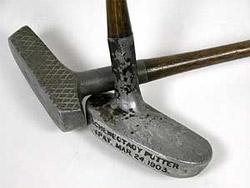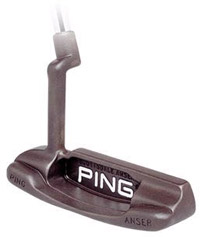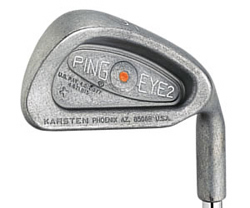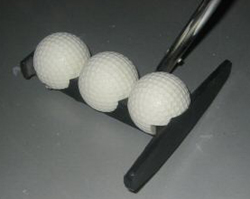 Giant club heads, exotic shafts, and weird-looking putters have become staples in the bags of players today. In fact, it seems every year brings a new twist on technology that prods players to keep pace.
Giant club heads, exotic shafts, and weird-looking putters have become staples in the bags of players today. In fact, it seems every year brings a new twist on technology that prods players to keep pace.
Yet it remains to be seen whether recent novelties like the moveable weights in the TaylorMade R7, the curious shapes of the Cleveland Hi-Bore and Nike SasQuatch drivers, and ever-stranger putters like the Hammy leave a lasting mark on the game.
Looking back, however, there have been clubs through the years that have had a seminal impact. Here’s a look at some of them whose influence is still seen today.
1904: Schenectady Putter
 The Schenectady putter is famous not so much for its design as for what it did to the rules of golf. In 1904, Walter Travis used the aluminum center-shafted mallet to become the first American to win the British Amateur. The R&A were not amused, particularly after Travis made some not-so-gracious remarks after his win.
The Schenectady putter is famous not so much for its design as for what it did to the rules of golf. In 1904, Walter Travis used the aluminum center-shafted mallet to become the first American to win the British Amateur. The R&A were not amused, particularly after Travis made some not-so-gracious remarks after his win.
Four years later they exacted their revenge by outlawing center-shafted putters. The USGA, however, chose to keep them legal. Thus began a decades-long schism between the two rules making bodies that resulted in such disparities as the smaller British ball. By the way, it wasn’t until 1952 that the R&A ruled center-shafted putters legal.
Nonetheless, the Schenectady putter proved a huge success with hundreds made and scores of copies fashioned of wood and steel.
1934: Sarazen Sand Iron
Club designers had been struggling for years to come up with a club that would work out of sand. Solutions like concave faces that could scoop the ball out and extremely deep and wide grooves that would impart spin when the ball was picked clean were quickly ruled illegal.
Enter Gene Sarazen who, inspired by the way a boat’s bow plowed through water, soldered a flange to the bottom of a niblick to create a heavier club with what is now known as bounce. The club changed forever the technique for hitting shots from sand. Nearly three quarters of a century later, the most popular sand wedges in the game are essentially the same design.
1966: Ping Anser Putter
 Karsten Solheim’s legendary status in club innovation began with his Anser putter. 40 years later, it is the most copied design in all of golf. Called the Anser because “answer” would not fit on the bumper of the putter, its shape was first doodled on the back of a 78-rpm record jacket.
Karsten Solheim’s legendary status in club innovation began with his Anser putter. 40 years later, it is the most copied design in all of golf. Called the Anser because “answer” would not fit on the bumper of the putter, its shape was first doodled on the back of a 78-rpm record jacket.
The putter caught on when Julius Boros won the 1967 Phoenix Open with it and the rest, as they say, is history. Ping putters have won more than 500 tournaments, and derivations of the Anser made by others have won countless more.
Cast in manganese bronze and featuring heel and toe weighting, a “plumber’s” neck, and slotted sole, its influence can be seen today in the putter inventory in every golf shop in every country in the world.
1979: TaylorMade Pittsburgh Persimmon Driver
 Metal-headed drivers had been made for years but never achieved commercial success until Gary Adams introduced his TaylorMade Pittsburgh Persimmon driver. Ron Streck and Jim Simons were the first to put it in play on the PGA Tour, with Simons using it to win the 1982 Crosby Clambake.
Metal-headed drivers had been made for years but never achieved commercial success until Gary Adams introduced his TaylorMade Pittsburgh Persimmon driver. Ron Streck and Jim Simons were the first to put it in play on the PGA Tour, with Simons using it to win the 1982 Crosby Clambake.
Not only did this club usher in the age of metal woods, it began a new era in product life cycles. Up until this club, drivers were considered unique works of art that were difficult to find and, once found, stayed in the bag forever. Players like Sam Snead and Jack Nicklaus used the same driver for decades.
The club’s success may also be traced to the concurrent introduction of truly playable graphite shafts… technology even Tiger Woods eventually succumbed to.
1982: Ping Eye2 Irons
 I’m hedging a bit here, since Ping’s early models (Karsten I-IV and Ping Eye) introduced cast cavity backs and color-coded lie angles. But it was the Ping Eye2 that brought the concepts to their highest form. In fact, many still say that the Eye2 is the best iron Ping ever made. It is still available through special order and still found today in the bags of some players on the PGA Tour.
I’m hedging a bit here, since Ping’s early models (Karsten I-IV and Ping Eye) introduced cast cavity backs and color-coded lie angles. But it was the Ping Eye2 that brought the concepts to their highest form. In fact, many still say that the Eye2 is the best iron Ping ever made. It is still available through special order and still found today in the bags of some players on the PGA Tour.
Forgetting for a moment every cavity-back iron it has since inspired, the Ping Eye2 may have made an even bigger impact on the game when in 1984 a “U” groove model was introduced.
The resulting “square grooves” controversy included a $100 million lawsuit filed by Ping against the USGA and R&A when they ruled the grooves nonconforming. The subsequent settlement forever compromised the power of the ruling bodies to legislate equipment design in subtle ways. I have no doubt this opened the door to the current age of technological revolution in clubs and balls.
1984: Dave Pelz Three-Ball Putter
 Like Karsten Solheim, Dave Pelz is an engineer by background who applied an engineer’s typical analytical thinking to the problem of putter alignment. He came up with a design that positioned three plastic golf balls behind the face.
Like Karsten Solheim, Dave Pelz is an engineer by background who applied an engineer’s typical analytical thinking to the problem of putter alignment. He came up with a design that positioned three plastic golf balls behind the face.
Early models were deemed non-conforming because they were deeper front to back that the face was wide, then later because they were considered “not plain in shape.” Thus his original designs never really took off.
But good ideas don’t go away. In 2002, after licensing the patent from Pelz, Odyssey introduced their line of two ball putters and watched as they became the most popular in all of golf. Keeping with a strategy of constant line expansion, they finally introduced a three-ball model we reviewed here. I’m sure Odyssey, and Pelz, are forever grateful for the concept. So, too, the myriad putter makers who have since come out with distinctive sight lines.
1985: Matzie Slim Jim Long Putter
The first long putter was the brainchild of then Senior Tour Player Charlie Owens. Made by the Matzie company and dubbed the Slim Jim putter, it was 46″ long and featured a small but incredibly heavy brass head. It immediately found a following on the professional tours and went on to spawn countless variations.
After considerable discussion and debate, the R&A and USGA ruled long putters legal. However, thanks to the effectiveness of long and belly putters and the ungainly (to some) look of the technique, there remain constant rumblings and rumors that putters anchored against the body may one day be banned.
Unfortunately, the putter did not prove a financial windfall for its first manufacturer. Matzie Golf was sold in 2003 and its principle, Ken Matzie, passed away last year at the age of 73.
1991: Callaway Big Bertha Driver
The clubs we’ve touched on here made a difference because they worked better than anything before. Callaway’s Big Bertha Driver was no different. I can tell you that at the time it was introduced, it seemed huge even though by today’s standards it was just a puny 190cc head.
What the Big Bertha driver did was to kick off the size race in driver design and, in a subsequent model, introduce titanium to the mix. The bigger head did work better as it was much more forgiving. Of course, once it was determined bigger was better, the ruling bodies had to step in and set a 460cc limit on head size.
With a size limit established, enter the age of new shapes and weight distribution. What will catch on? Just stay tuned. It should be interesting.
In the End…
As a long-time equipment freak, from 1966 on I owned and played every one of the innovations listed above almost as soon as they came out, except the Pelz putter. Unfortunately, staying on the cutting edge never really changed my scores all that much. But more forgiving, efficient clubs have indeed made the game more fun. And maybe that’s the whole point of club innovation.
So this is my list. Any that I missed?

Jack: Great trip down memory lane. I’d have to add the Strata golf ball in 1996 (first solid-core three-piece performance golf ball) and the first Odyssey Dual Force putters from 1993-94 (started the insert craze in putters to counteract the increasingly hard cover of modern golf balls), and maybe the Nicklaus/MacGregor Response putter Jack used to win the 1986, which might have been the first truly oversized golf club.
Great article indeed Jack! I’m no equipment guru, so these kind of lists are fun for me to read.
That damned Matzie Slim Jim Long putter! I’m not a fan of long putters, and now I know who to blame for the invention.
Very entertaining stroll down memory lane.
What about the Cobra Baffler…the grandaddy of all hybrids?
Thanks for the comments and additions, guys!
Actually, the baffler, the TaylorMade Raylor and the Ginty trouble wood almost made the list. As I understand the story, Gary McCord approached TaylorMade with the idea of combining the attributes of the Ginty with the Raylor to produce the first hybrid. But since that was hard to trace down and because, in fact, the distinction may belong to all three, I left them off this list.
I also purposely left out balls… for the moment. Maybe we’ll trace that history in a future column!
I thought John Riley patented the first metal driver? It says this on their web site as well
Hard to say. The basis for the Riley patent appears to be a plastic core inside the metal head. Other metal drivers without plastic cores could have pre-dated Riley.
The Riley driver did have a unique core. The reason I listed the Pittsburgh Persimmon was that it was clearly the first metal driver to capture (and ultimately change) the market.
One of the first companies to jump on the metal driver bandwagon was The Founders Club which, for a time, were almost as popular as the Taylor Made’s. Alas, they never ascended to the position where they could be bought by addidas and continue to be part of the evolution.
Thank you for the responses
I have played with a custom set of Riley’s for about 20 years now and yes I play with new tech woods but I am yet to find irons that beat these. I have few freinds that can hit better with new technology the only thing I need is re finishing and sharper groves.
A delightful article with a perspective on the history of the equipment itself. Call me an idiot, or a traditionalist, but I am still using persimmon woods during just 30 years of playing the game, from the time I was 13. The PGAtour.com website cites the fact(?) that the same distance can be achieved with wood woods as with metal drivers. Are what some call advances, really just changes and not really any progression, per se?
Sure, the last hickory shaft stick used to win a major event (U.S. Amatuer) was pre-World War II, but hear this here first: could a PGA Tour event be held (like in auto racing, with a historic series), where only equipment from days of yore is authorized and allowed? The tour sponsors could bring back a whole realm of name brands and prove their tenured pedigrees, and hype their usual new and improved models to generate interest. The hounds for equipment at garage sales would be prompted to be more competitive, and who knows, maybe the modernists as well as the traditionalists (the idiots?) among us, would be shown a thing or two.
Is there a golf course in the United States
or Canada, that equally challenges
right-handed and left-handed golfers?
Meaning: the front and back nine are
mirror images. There are equal amount of
doglegs to the left and right.
On the surface, it may appear that a dogleg
to the right, favours a leftie; through the
option to drive over trees. However, even
a rightie with reliable FADE, may re-think
his or her game, if they are faced with
trees sitting too close to their left when
driving off the tee.
Enjoyed your listing of innovative changes to the game! Heaven knows you could have made that one long list if you really wanted to : )! I have been a collector for over 40 years and like yourself, have seen many changes, as well as, read about those that took place well into our past! The one area that I am surprised about that was neglected, was the creation of the metal/steel shaft… then later, obviously, ALL of the others!!! That single innovation eventually brought a “cheaper” club to the masses, allowed more people into an otherwise very expensive game/hobie and started the whole concept of club fitting!! Next to the advent of the gutty ball in 1850… the surlyn ball of the 1960’s and the “oversized’ behemouths of the 2000’s… I think you have all covered : ))!
What about consideration for Tommy Armour 693,945 and m85 of the late 40’s – early 50’s all of which was oil hardened persimmon….and the Wilson irons bullet and button back along with all the fluid feel (black dot).
8802 putter style, bullseye style. Most important the Killer Bee; first super long driver mass marketed. Ping K-1 woods too. I think your list is way too incomplete.
Jack:
Recently purchased a Charles L. Owens, signature, Slim Jim, Matzie putter 50 inches long with double grip, at an antique mall. I like unusual putters and this one I hadn’t seen before. I also have a Dave Pelz 3 ball putter that I have never used either, and didn’t know they were non-conforming. I have another unusual putter 39 inches long with a funny looking head that I have never seen before, but will have to do more research on this one. This was an excellent article on the progress of club innovation. Keep up the good work.
Good history! I have been in the golf industry with store fronts but now just sell a little on E-bay. We have watched the industry change so, and not in the best interest of golf…. I feel that there is no interest in the old timers and the new “guns” are mostly spoiled by the tons of money now in the PGA tourney’s.
Knowing there are other equipement nuts and true history buffs out there is comforting. Good reading keep it going.